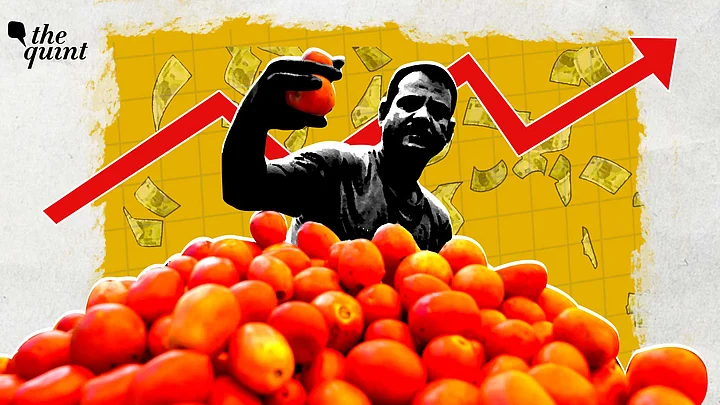From the humble tomato curry to the tangy tomato chutney, tomato, a versatile fruit, has always held a special place in the Indian culinary repertoire. But in a twist that would make even the most seasoned chef raise their eyebrow, tomatoes have stealthily transformed from kitchen heroes to budget busters across the country.
As tomato prices skyrocket leaving wallets empty, it's time to peel back the layers of this juicy conundrum and examine the impact on the everyday lives of the general public.
What's happening? The prices of tomato across the country has rose from Rs 10-20 per kg to a price of Rs 80-100 per kg within a span of just two to three days, The Hindu reported.
In Vishakapatnam and Vijayawada in Andhra Pradesh, the prices of tomatoes have gone up between Rs 90 and Rs 120. What was hovering around Rs 30 has shot up to Rs 100 within days in Bengaluru. Similarly, in Telangana, tomatoes are priced at Rs 90 and in Kochi and other major parts of Kerala, the prices have hit the century mark. Kanpur in Uttar Pradesh and the financial capital Mumbai were also on the list of cities impacted by the sky-high tomato prices, with rates reaching Rs 80 per kg.
Why the sudden surge? According to trade experts, the availability of tomatoes has been impacted due to floods and heavy rainfall in significant cultivation regions. Recent rainfall has affected states such as Karnataka, Telangana, and some hilly regions, resulting in crop damage and causing disruptions in the tomato supply chain. The delayed monsoons, high temperatures, and low production have severely impacted tomato prices across India.
"The price hike of tomatoes is primarily because of the dip in supply due to heatwaves in tomato-growing areas and heavy rain, including the recent unseasonal rain and flooding in Andhra Pradesh and Karnataka during the harvest periods."Prakash, A Vegetable Vendor
The recent heavy rainfall in various regions of Tamil Nadu has caused significant damage to tomato crops, resulting in a shortage of supply and a staggering increase in prices up to Rs 110. Additionally, several other vegetables including beans, brinjal, drumstick, carrot, beetroot, onions, and potatoes have also seen a sharp rise in prices.
Based on the records maintained by the Price Monitoring Division within the Department of Consumer Affairs, the average retail price of tomatoes increased from Rs 25 to Rs 41 per kilogram. The highest prices observed in retail markets ranged from Rs 80 to Rs 113 per kilogram. Alongside this, the prices of essential vegetables followed a similar trend, with wholesale market prices experiencing an average increase of about 60-70 percent during the month of June.
What's the Impact of Soaring Tomato Prices on Households?
The impact of skyrocketing tomato prices on household budgets has been quite significant. Especially since tomatoes are a staple ingredient in many Indian dishes, the increase in prices has led to a rise in overall food expenses. Households with limited budgets are forced to reduce their consumption of tomatoes and adjust their meal plans to accommodate the increased cost.
Additionally, households that rely on the tomato market for income, such as small-scale farmers or vendors, face severe challenges. While higher prices could potentially benefit some producers, some claim that they are unable to meet the increased demand and that they are negatively affected by other factors like transportation costs, hence their overall profitability is still impacted.
Rekha, a homemaker from a lower middle-class family told The Quint:
"My husband works as a security guard in an apartment. I have a 3-month-old baby, and we run the family with his meagre income of Rs 8,000. The sudden increase in tomato prices has hit our household budget hard. Tomatoes are an essential ingredient in our daily meals and we rely on them for their nutritional value and flavour. With skyrocketing prices, we have to think twice before adding tomatoes to our shopping list. We are now forced to find alternatives or reduce our consumption, which compromises the taste and variety of our meals."Rekha, Homemaker
What's the Impact of Tomato Prices on Vendors, Hoteliers?
The combination of rising tomato prices and people's reluctance to buy them has taken a toll on vendors.
Ravi Kumar, a small-scale vendor from Chennai said, ”The tomato price hike has made it challenging for us to sustain our businesses. We rely heavily on the sale of tomatoes to earn a livelihood. The rising prices make it difficult to offer competitive rates to our customers. Moreover, the uncertainty in tomato availability and fluctuating prices affect our profit margins. We have to constantly adapt to the changing market conditions and strategize to minimize losses while meeting the demand of our customers."
"Tomatoes are one of the most sought-after items in our inventory, but now we struggle to sell them. The soaring prices have deterred customers from purchasing tomatoes, as they look for cheaper alternatives or reduce their consumption altogether. This has resulted in a significant drop in our tomato sales, affecting our revenue and profitability. We are left with surplus stock that we struggle to sell, and the perishable nature of tomatoes adds to the challenge."Ravi Kumar, a small-scale vendor
Rajesh, a restaurant owner of Bengaluru said, "The rising tomato prices have severely impacted our business significantly increasing our operational costs. To maintain profitability, we are left with no choice but to either reduce the quantity of tomatoes used in our recipes or increase the prices on our menu. Unfortunately, this affects our customers, who may hesitate to dine with us due to the increased costs."
(At The Quint, we question everything. Play an active role in shaping our journalism by becoming a member today.)
